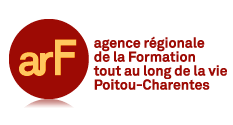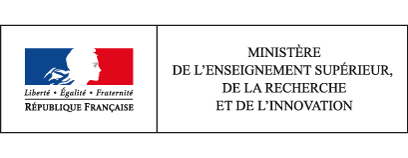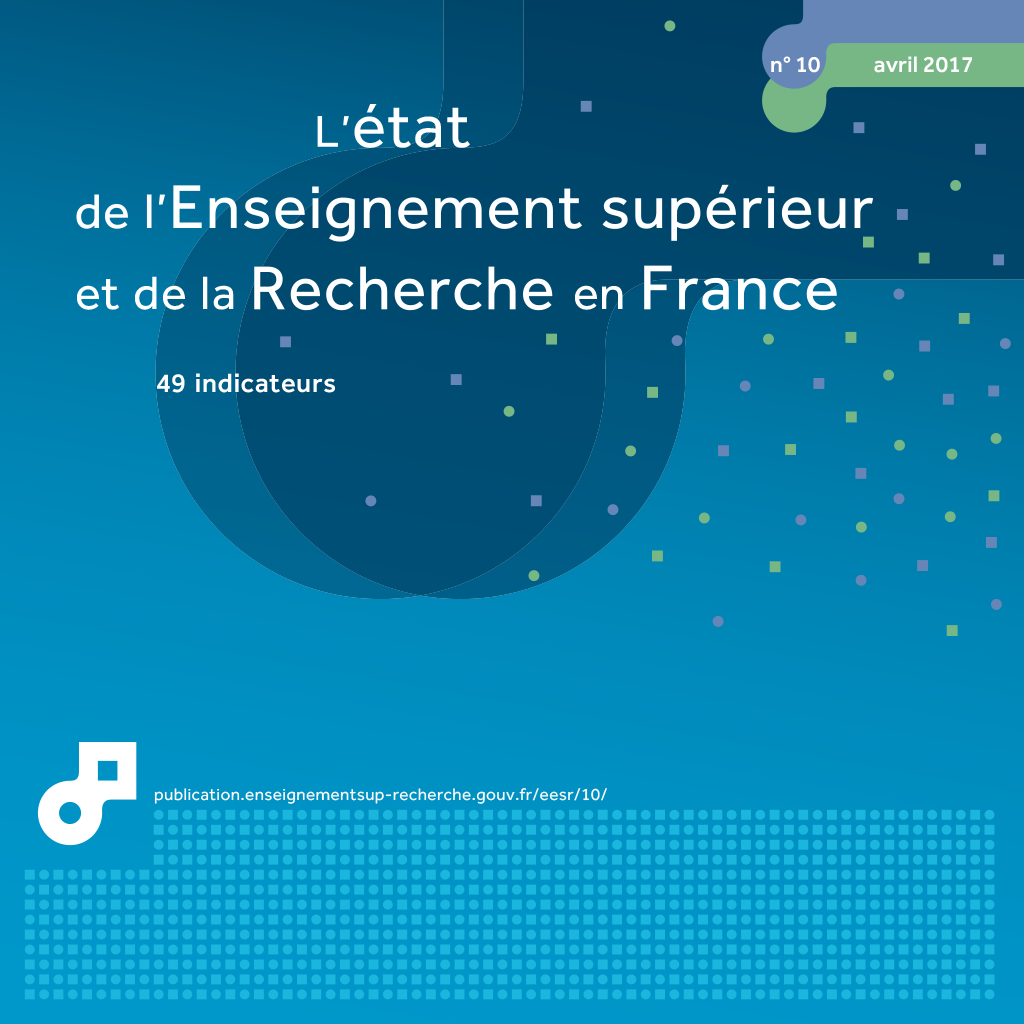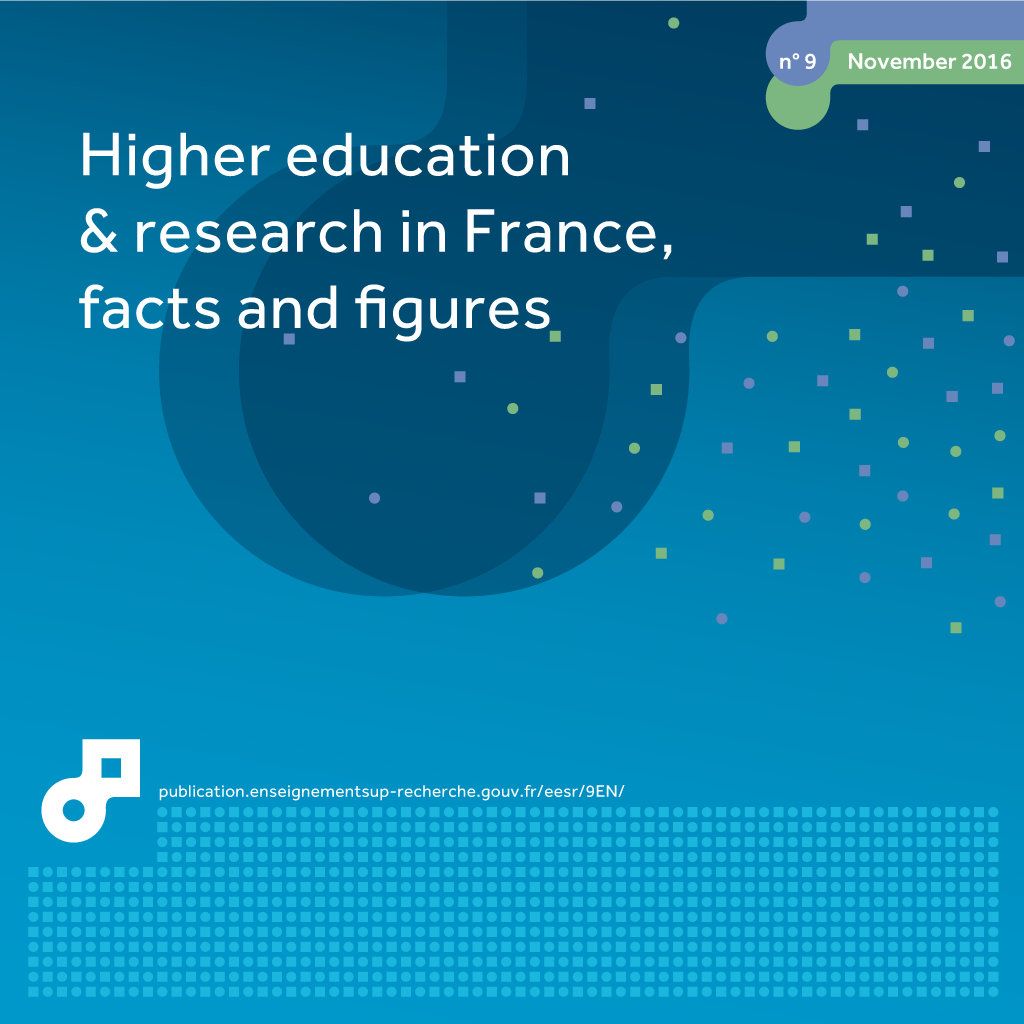 Les compétences transversales et transférables sont désormais reconnues et recherchées par les employeurs. Les repérer et les prendre en compte permettrait d’améliorer l’appariement entre offre et demande de travail. Le réseau Emploi Compétences, animé par France Stratégie, consacre un rapport aux outils de repérage, de reconnaissance et de valorisation.
Les compétences transversales et transférables sont désormais reconnues et recherchées par les employeurs. Les repérer et les prendre en compte permettrait d’améliorer l’appariement entre offre et demande de travail. Le réseau Emploi Compétences, animé par France Stratégie, consacre un rapport aux outils de repérage, de reconnaissance et de valorisation.
Consulter le rapport. Voir l'article...
L'état de l’Enseignement supérieur et de la Recherche en France - A8 niveaux de formation
 L'état de l’Enseignement supérieur et de la Recherche en France constitue un état des lieux annuel et chiffré du système français, de ses évolutions, des moyens qu’il met en œuvre et de ses résultats, en le situant, chaque fois que les données le permettent, au niveau international.
L'état de l’Enseignement supérieur et de la Recherche en France constitue un état des lieux annuel et chiffré du système français, de ses évolutions, des moyens qu’il met en œuvre et de ses résultats, en le situant, chaque fois que les données le permettent, au niveau international.
A8 niveaux de formation
Nomenclature nationale des niveaux fixée par la Commission statistique nationale de la formation professionnelle et de la promotion sociale
Niveau Vbis : sorties de 3e générale, de 4e et 3e technologiques et des classes du second cycle court avant l’année terminale.
Niveau V : sorties de l’année terminale des cycles courts professionnels et abandons de la scolarité du second cycle long avant
la classe terminale.
Niveau IV : sorties des classes terminales du second cycle long et abandons des scolarisations post-baccalauréat avant d’atteindre le niveau III.
Niveau III : sorties avec un diplôme de niveau bac + 2 ans (DUT, BTS, DEUG, écoles des formations sanitaires ou sociales, etc.)
Niveaux II et I : sorties avec un diplôme de deuxième ou troisième cycle universitaire, ou un diplôme de grande école.
CITE 1 : enseignement primaire
CITE 2 : enseignement secondaire de premier cycle
CITE 3 : enseignement secondaire de second cycle
CITE 4 : enseignement post-secondaire n’appartenant pas à l’enseignement supérieur (peu développé en France : capacité en Droit, préparation DAEU)
CITE 5 : enseignement supérieur de premier et deuxième cycles
CITE 5A, dit aussi enseignement supérieur de « type universitaire » : préparations des Licences et Masters (disciplines générales des universités, diplômes d’écoles d’ingénieurs, de commerce, etc.)
CITE 5B : enseignement supérieur finalisé (DUT, BTS, formations paramédicales et sociales, etc.)
CITE 6 : enseignement supérieur de troisième cycle (doctorat de recherche)
Cette classification vise à produire des statistiques comparables dans les différents pays sur l’enseignement et la formation. C’est un accord international, sous l’égide de l’UNESCO. Cette classification permet de répartir en fonction des cycles d’enseignement les effectifs d’étudiants, les flux de diplômés, les finances. Elle est utilisée également pour répartir la population par niveaux d'études ; les études prises en compte sont celles couronnées de succès et sanctionnées par un diplôme. Voir l'article...
Higher Education and Research, Facts and Figures - 02 expenditure on tertiary education in OECD countries
 Like the previous editions, the 9th edition of Higher Education and Research in France, Facts and Figures presents an annual overview, backed up by figures, of developments within the French system, its resources and outcomes.
Like the previous editions, the 9th edition of Higher Education and Research in France, Facts and Figures presents an annual overview, backed up by figures, of developments within the French system, its resources and outcomes.
02 expenditure on tertiary education in OECD countries
In 2012, average expenditure per student in France was close to the average of OECD countries. Since 2005, it has increased more quickly than in the marority of countries, thus catching up considerably on its shortfall. However, national expenditure on tertiary education is still slightly below the average (1.4% of GDP compared to 1.5%).
International comparisons of education expenditure are somewhat difficult due to the demographic and socio-economic diversity of the different countries and their national education systems. In tertiary education, this difficulty is reinforced by the wide variety of educational structures at this level. Nevertheless, the situation of France can be assessed using some general indicators. More...
Higher Education and Research, Facts and Figures - 01 education expenditure on tertiary education
 Like the previous editions, the 9th edition of Higher Education and Research in France, Facts and Figures presents an annual overview, backed up by figures, of developments within the French system, its resources and outcomes..
Like the previous editions, the 9th edition of Higher Education and Research in France, Facts and Figures presents an annual overview, backed up by figures, of developments within the French system, its resources and outcomes..
The nation spent €29.2 billion (€bn) on tertiary education in 2014. This is 2.6 times more than in 1980 (in constant euros). The contribution by central government represented 69% of that amount. In 2014, average expenditure per student stood at €11,560, or 40% more than in 1980 (in constant euros)
In 2014, the nation (central government, local authorities, other public administrative bodies, households and companies) dedicated €29.2 billion to tertiary education, a fall of 0.3% over 2013 (at constant prices). Since 1980, expenditure on tertiary education has seen strong growth of 2.8% per year on average. Its share of domestic education expenditure (DEE) increased from 15.1% in 1980 to 20.0% in 2014 (table 01.01).
Over the whole period, DEE on tertiary education was multiplied by 2.6 in constant euros (chart 01.02). Despite this significant increase, average expenditure per student rose by only 39.7% due to a doubling of student numbers. Over the same period, average expenditure per secondary school pupil increased by 65.9%. Over the period 2006-2009, when there was both a rapid increase in DEE and a slowdown in student enrolment, expenditure per student increased by 3.5% on average per year. Since 2009, however, the slowdown in DEE combined with a new rise in the student numbers has resulted in a drop in spending per student of 0.7% annualy 1.
Average expenditure per student stood at €11,560 in 2014 (chart 01.03). Although it may be difficult to compare the cost of different curricula directly, especially since research expenditure is included in the university totals, there are considerable differences from one branch of study to another. The cost varies from €10,800 euros per year for a university student to €14,980 for a pupil in a class preparing for admission to Grandes Ecoles (CPGE). However, in recent years, the gap between these average expenditure figures has tended to narrow (chart 01.03).
More than seventy per cent of total expenditure goes on staff, especially teachers' wages (41%) (chart 01.04).
With no repeat years, leading to a Bachelor's degree (via a general or technology second cycle) was estimated in 2014 to be €148,590, while a 17-year education leading to an Advanced technician diploma (BTS) (via a vocational upper secondary cycle) would cost the nation €146,620.
In terms of initial funding (see definitions opposite), central government contributes the major share of DEE for tertiary education (69.0%) while local authorities contribute 10.9% and households 8.6% (table 01.01). In terms of final funding, i.e. after including grants in the household budget, the household share practically doubles (16.8%). Some direct or indirect support, funded by the central government and which benefit students or their families, do not appear in the DEE for tertiary education: these are related to taxation (increase in family quotient) or are not directly linked to student status (social housing benefit). If they were included (excluding social welfare payments), expenditure per student in 2014 would then increase €11,560 to €12,780. More...
A7 how changes to GDP measurement methodology automatically led to a drop in the R&D effort
 The data on the R&D effort in OECD countries used here (chapter 27) are taken from the OECD's MSTI database, which was updated in June 2014. For the purposes of this database, the R&D effort was calculated using the unrevised GDP data to ensure that it remains comparable, as not all European countries implemented this change at the same time. However, in the rest of the document, the GDP used has 2010 as the base year (as revised in May 2014). More...
The data on the R&D effort in OECD countries used here (chapter 27) are taken from the OECD's MSTI database, which was updated in June 2014. For the purposes of this database, the R&D effort was calculated using the unrevised GDP data to ensure that it remains comparable, as not all European countries implemented this change at the same time. However, in the rest of the document, the GDP used has 2010 as the base year (as revised in May 2014). More...
Higher Education and Research, Facts and Figures - A8 levels of educational attainment
 Like the previous editions, the 9th edition of Higher Education and Research in France, Facts and Figures presents an annual overview, backed up by figures, of developments within the French system, its resources and outcomes.
Like the previous editions, the 9th edition of Higher Education and Research in France, Facts and Figures presents an annual overview, backed up by figures, of developments within the French system, its resources and outcomes.
A8 levels of educational attainment
French classification of levels of educational attainment defined by the French statistical commission on vocational training and social advancement
Level Vb: those who left education in the 4th year of general secondary education, the 3rd or 4th year of a technical secondary course or shorter secondary education courses before the final year.
Level V: those who left education having completed the final year of a short vocational course or dropped out of schooling during general secondary education before the final year.
Level IV: those who left education having reached the final year of general secondary education or who dropped out of education after the baccalauréat without reaching Level III.
Level III: those who left education having obtained a 'Bac + 2' qualification marking the successful conclusion of two years of higher education following the baccalauréat (technological university diploma (Diplôme universitaire de technologie - DUT), higher technical certificate (Brevet de technicien supérieur - BTS), diploma of general university studies (Diplôme d’études universitaires générales - DEUG), nursing and social training courses, etc.).
Levels II and I: those who left education having obtained a Bachelor's degree-level or postgraduate qualification or a diploma awarded by a Grande École.
ISCED level 1: primary education
ISCED level 2: lower secondary education
ISCED level 3: upper secondary education
ISCED level 4: post-secondary non-tertiary education (uncommon in France: basic legal qualification (capacité en Droit), diploma giving access to university studies (Diplôme d’accès aux études universitaires - DAEU)
ISCED level 5: short-cycle tertiary education
ISCED 5A, tertiary-type A programmes: preparation for Bachelor's and Master's degree programmes (general subjects at universities and qualifications awarded by engineering or business schools, etc.)
ISCED 5B: tertiary-type B programmes (DUT, BTS, paramedical and social care qualifications, etc.)
ISCED level 6: doctoral or equivalent level
The purpose of this classification is to produce statistics on education and training that are comparable between different countries. It is an international agreement organised by UNESCO. It makes it possible to break down the numbers of students, changes in graduate numbers and finances in terms of cycles of education. It is also used to break down the population in terms of levels of educational attainment. Only successful studies for which students obtain a qualification are taken into account. More...
Higher Education and Research, Facts and Figures - Summary
 Like the previous editions, the 9th edition of Higher Education and Research in France, Facts and Figures presents an annual overview, backed up by figures, of developments within the French system, its resources and outcomes. Wherever the data permit, an international comparison is provided. A double page is devoted to each theme (50 in total), including a summary of the main data available and several graphs and tables as illustrations. This publication relies on key national and international statistical sources providing data on higher education and research in France.
Like the previous editions, the 9th edition of Higher Education and Research in France, Facts and Figures presents an annual overview, backed up by figures, of developments within the French system, its resources and outcomes. Wherever the data permit, an international comparison is provided. A double page is devoted to each theme (50 in total), including a summary of the main data available and several graphs and tables as illustrations. This publication relies on key national and international statistical sources providing data on higher education and research in France.
2014, stabilisation of expenditure on higher education after a long period of high growth
In 2014, the French nation spent €29.2 billion on higher education, an increase of 0.3% in comparison with 2013 (at constant prices, i.e. adjusted for inflation). Expenditure on higher education has more than doubled since 1980 (by a factor of 2.6, at constant prices), increasing by an average of 2.8% a year. In 2014, average expenditure per student in higher education totalled €11,560, 40% more than in 1980. More...
Higher Education and Research, Facts and Figures - Preface
 Promoting the development and transfer of knowledge, know-how and technology is a fundamental challenge in our society. Raising the level of general education, providing a range of courses consistent with young people's aspirations and the needs of our economy, focusing research on the major challenges facing us and putting in place suitable structured, incentive-based systems are at the heart of the government's action in the field of higher education and research. More...
Promoting the development and transfer of knowledge, know-how and technology is a fundamental challenge in our society. Raising the level of general education, providing a range of courses consistent with young people's aspirations and the needs of our economy, focusing research on the major challenges facing us and putting in place suitable structured, incentive-based systems are at the heart of the government's action in the field of higher education and research. More...
L'état de l'Enseignement supérieur et de la Recherche en France (n°10 - Avril 2017)
 La 10e édition de L'état de l'enseignement supérieur et de la recherche (E.E.S.R) présente un état des lieux annuel et chiffré du système français d'enseignement supérieur et de recherche. L'E.E.S.R. propose, dans sa version numérique, de nouvelles fonctionnalités aux utilisateurs, comme par exemple la description détaillée des principales sources mobilisées et de leur mode d’élaboration.
La 10e édition de L'état de l'enseignement supérieur et de la recherche (E.E.S.R) présente un état des lieux annuel et chiffré du système français d'enseignement supérieur et de recherche. L'E.E.S.R. propose, dans sa version numérique, de nouvelles fonctionnalités aux utilisateurs, comme par exemple la description détaillée des principales sources mobilisées et de leur mode d’élaboration.
L'état de l'enseignement supérieur et de la recherche par thématique
49 thèmes sont abordés dans cette 10e édition. Chaque fiche est présentée au moyen de graphiques, de tableaux et de commentaires, et présente les dernières données de synthèse disponibles sur chaque sujet. Ces données sont issues des services statistiques du M.E.N.E.S.R. mais également d'autres organismes tels que l'INSEE, le Céreq, l'O.V.E. ou l'O.S.T. du HCERES.
Enseignement supérieur
-
- 01. la dépense d’éducation pour l’enseignement supérieur
- 02. la dépense pour l’enseignement supérieur dans les pays de l’OCDE
- 03. l’aide sociale aux étudiants
- 04. les personnels enseignants de l'enseignement supérieur public sous tutelle du MENESR
- 05. les personnels non-enseignants de l’enseignement supérieur public sous tutelle du MENESR
- 06. qualification et recrutement des enseignants-chercheurs
- 07. le baccalauréat et les bacheliers
- 08. voeux d'orientation et propositions exprimés sur le portail Admission post-Bac (APB)
- 09. les évolutions de l'enseignement supérieur depuis 50 ans
- 10. l’accès à l’enseignement supérieur
- 11. le profil des nouveaux bacheliers entrant dans les principales filières du supérieur
- 12. les étudiants en formation dans l’enseignement supérieur
- 13. la parité dans l'enseignement supérieur
- 14. les étudians en situation de handicap dans l'enseignement supérieur
- 15. les étudiants étrangers dans l’enseignement supérieur
- 16 emploi du temps et rythmes d'études
- 17 l'apprentissage dans le supérieur
- 18. parcours et réussite en STS, IUT et CPGE
- 19. les parcours et la réussite en Licence, Licence professionnelle et Master à l'université
- 20. le niveau d'études de la population et des jeunes
- 21. le niveau d'études selon le mileu social
- 22. l'insertion professionnelle des diplômés d'université (Master, DUT, LP)
- 23. évolution de l'insertion à 3 ans des sortants de l'enseignement supérieur, de la Génération 1998 à la Génération 2010
- 24. la formation continue dans l’enseignement supérieur
- 25. la validation des acquis de l'expérience dans l'enseignement supérieur
Recherche
-
- 26. l’effort de recherche et développement en France
- 27. les dépenses intérieures de recherche et développement
- 28. la R&D dans les PME, les ETI et les grandes entreprises
- 29. les dépenses de recherche des organismes publics
- 30. le financement des activités de recherche et développement de la recherche publique
- 31. le crédit d'impôt recherche, dispositif de soutien à la R&D des entreprises
- 32. le financement de la R&T par les collectivités territoriales
- 33. les objectifs socio-économiques des crédits budgétaires consacrés à la recherche
- 34. le financement et l'exécution de la R&D en France
- 35. les moyens humains de la recherche et développement
- 36. la parité dans la recherche
- 37. les chercheurs en entreprises
- 38. le doctorat et les docteurs
- 39. l'évolution depuis 10 ans du dévenir professionnel des docteurs
- 40. les jeunes entreprises innovantes
- 41. la R&D en biotechnologie dans les entreprises
- 42. la R&D en nouveaux matériaux et en nanotechnologies dans les entreprises
- 43. les activités de R&D dans le numérique
- 44. la recherche en environnement
- 45. la France dans l'espace européen de la recherche via sa participation à Horizon 2020
- 46. le profil scientifique de la France à travers ses publications
- 47. le positionnement de la France à travers ses publications
- 48. le positionnement de la France dans le domaine de la recherche biomédicale à travers ses publications scientifiques
- 49. la position technologique en France
Annexes
- A1. étudiants inscrits dans l'enseignement supérieur
- A2. R&D en France
- A3. MIRES - Programmes LOLF pour la recherche
- A4. table des objectifs socio-économiques
- A5. les objectifs socio-économiques retenus pour l'évaluation de la dépense de R&D en environnement
- A6. précisions méthodologiques - Enquête sur les moyens consacrés à la R&D
- A7. la révision méthodologique de la mesure du PIB entraîne une baisse mécanique de l’effort de recherche
- A8. niveaux de formation
L'édition 2017 de l'E.E.S.R. : une version numérique enrichie
Depuis 2014, l'état de l'Enseignement supérieur et de la Recherche est disponible en version entièrement numérique afin d'améliorer le service rendu aux utilisateurs. Disponible sur les 3 dernières éditions, celle-ci est conçue pour être consultable quel que soit le support utilisé : mobile, tablette, ordinateur portable ou de bureau. Elle offre des fonctionnalités avancées de recherche, lexique, suggestion de contenus associés. Les données à l’appui des tableaux, graphiques et illustrations sont accessibles dans un format ouvert et sous Licence ouverte et des liens vers les jeux de données ouverts associés sont proposés.
Pour cette 10e édition, des chiffres-clés sont associés à chaque fiche. Ils sont également regroupés au sein d'une rubrique dédiée qui propose aux lecteurs une exploration par thématique. Le site s'est enrichi de fonctionnalités facilitant la reprise des informations dans des sites tiers (sous forme de liens intégrables) ou dans les principaux réseaux sociaux. Voir l'article...
Les dépenses de R&D des entreprises en 2015 (données provisoires) - Note Flash n°3 - avril 2017







/https%3A%2F%2Fprofilepics.canalblog.com%2Fprofilepics%2F1%2F0%2F1076071.jpg)